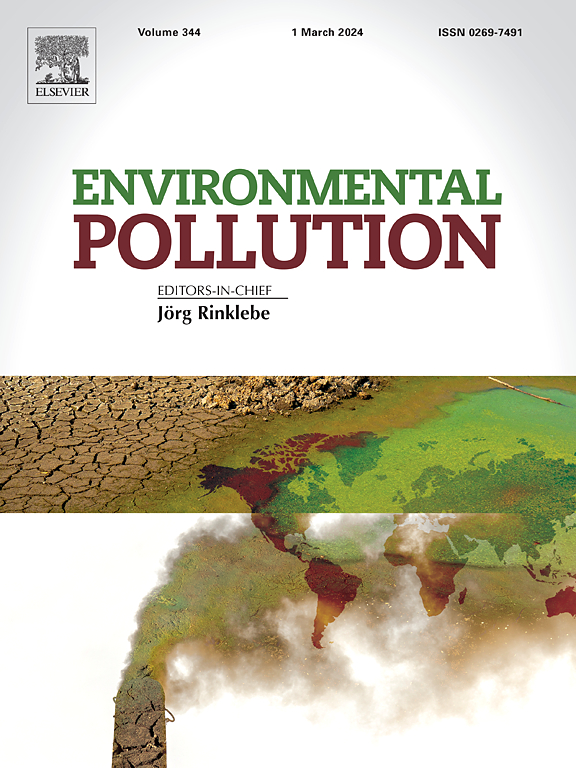Pollution and partitioning of neonicotinoid insecticides in free-grazing ducks and their eggs: Implications for human health
IF 7.3
2区 环境科学与生态学
Q1 ENVIRONMENTAL SCIENCES
引用次数: 0
Abstract
Neonicotinoid insecticides are used extensively in many pest control schemes across the globe; but little is known about their impacts on free-grazing domestic birds and the quality of meat or eggs produced from such birds. This study assessed the pollution and partitioning of neonicotinoids in serum and eggs of free-grazing ducks from 5 provinces of Thailand and elucidated the associated human health implications. Biological samples (duck serum, egg albumins, and egg yolks) and environmental samples (soil, water, feed) were collected from 9 duck farms in Thailand and subjected to LC/MS/MS analysis. Out of 6 neonicotinoid compounds targeted, five were detected in duck serum. Imidacloprid had the greatest median concentration of 1.4 ng/mL and the highest detection frequency (df) of 85.8 % in the ducks′ serum, followed by acetamiprid (median concentration = 0.4 ng/mL; df = 2.8 %), clothianidin (median concentration = 0.2 ng/mL; df = 9.4 %) or thiamethoxam (median concentration = 0.2 ng/mL; df = 7.5 %) and dinotefuran (only one sample was contaminated with 6.3 ng/mL of dinotefuran). The neonicotinoids were similarly detected in soil, water, and feed samples obtained from the duck farms, suggesting that the ducks were exposed to the insecticides from the nearby agricultural fields. The neonicotinoid compounds selectively accumulated in the albumin of duck eggs compared to yolk. The median concentration ratios of albumin to yolk obtained for imidacloprid, dinotefuran, thiamethoxam, clothianidin, and acetamiprid were 694, 463, 458, 382, and 263, respectively. However, upon human health risk analysis, levels of neonicotinoids detected in duck eggs were not found to present any appreciable risks to duck egg consumers.


自由放牧鸭子及其卵中新烟碱类杀虫剂的污染和分馏:对人类健康的影响
新烟碱类杀虫剂在全球许多虫害防治方案中广泛使用;但人们对它们对自由放牧的家禽的影响以及这些家禽的肉或蛋的质量知之甚少。本研究评估了来自泰国5个省的自由放牧鸭的血清和蛋中新烟碱类的污染和分配,并阐明了相关的人类健康影响。从泰国9个鸭场采集生物样品(鸭血清、蛋白蛋白和蛋黄)和环境样品(土壤、水、饲料),进行LC/MS/MS分析。在鸭血清中检测到6种新烟碱类化合物。鸭血清中吡虫啉的中位浓度最高,为1.4 ng/mL,检出率(df)最高,为85.8%,其次是啶虫啉(中位浓度为0.4 ng/mL;df=2.8%)、噻虫胺(中位浓度=0.2 ng/mL;df=9.4%)或噻虫嗪(中位浓度=0.2 ng/mL;df=7.5%)和呋虫胺(只有一个样品被6.3 ng/mL呋虫胺污染)。在从鸭场获取的土壤、水和饲料样本中也同样检测到新烟碱类,这表明鸭子接触了来自附近农田的杀虫剂。与蛋黄相比,新烟碱类化合物在鸭蛋白蛋白中选择性积累。吡虫啉、呋虫胺、噻虫嗪、噻虫脒和啶虫脒的白蛋白与蛋黄的中位数浓度比分别为694、463、458、382和263。经人类健康风险分析,在鸭蛋中检测到的新烟碱含量并未发现对鸭蛋消费者构成任何明显的风险。
本文章由计算机程序翻译,如有差异,请以英文原文为准。
求助全文
约1分钟内获得全文
求助全文
来源期刊

Environmental Pollution
环境科学-环境科学
CiteScore
16.00
自引率
6.70%
发文量
2082
审稿时长
2.9 months
期刊介绍:
Environmental Pollution is an international peer-reviewed journal that publishes high-quality research papers and review articles covering all aspects of environmental pollution and its impacts on ecosystems and human health.
Subject areas include, but are not limited to:
• Sources and occurrences of pollutants that are clearly defined and measured in environmental compartments, food and food-related items, and human bodies;
• Interlinks between contaminant exposure and biological, ecological, and human health effects, including those of climate change;
• Contaminants of emerging concerns (including but not limited to antibiotic resistant microorganisms or genes, microplastics/nanoplastics, electronic wastes, light, and noise) and/or their biological, ecological, or human health effects;
• Laboratory and field studies on the remediation/mitigation of environmental pollution via new techniques and with clear links to biological, ecological, or human health effects;
• Modeling of pollution processes, patterns, or trends that is of clear environmental and/or human health interest;
• New techniques that measure and examine environmental occurrences, transport, behavior, and effects of pollutants within the environment or the laboratory, provided that they can be clearly used to address problems within regional or global environmental compartments.
 求助内容:
求助内容: 应助结果提醒方式:
应助结果提醒方式:


